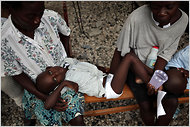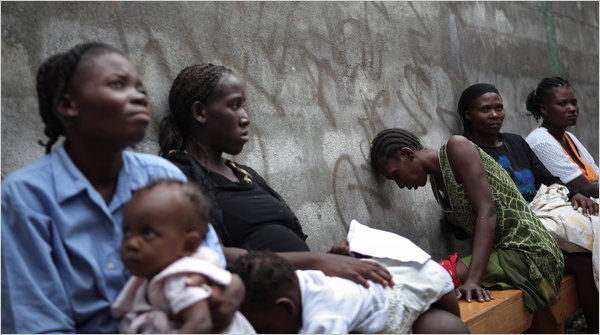PORT-AU-PRINCE, Haiti — A cholera outbreak that had been largely confined to the countryside has now begun to spread in the teeming capital filled with overcrowded, unsanitary earthquake survivor camps, prompting the authorities on Tuesday to brace for a more severe epidemic than previously thought.
Medical officials say they believe that there are at least 73 cases here in the capital and, based on outbreaks in other countries, they fear that cholera may become a way of life that could afflict as many as 270,000 people over the next several years.
 |
|
DAMON WINTER/THE NEW YORK TIMES |
| A young boy waits to see a doctor at a hospital in Port-au-Prince. |
The problem will be exacerbated by the country’s crippled state since the Jan. 12 earthquake, which killed upwards of 250,000 people and left one million homeless, living in squalid tent encampments. A hurricane last week killed another 21 people and left 6,610 homeless, causing flooding that could spread the disease.
“Cholera is a complex public health emergency under any circumstances,” said Jon Kim Andrus, deputy director of the Pan American Health Organization. “In Haiti, the hemisphere’s poorest country, the problem is even more complex.”
The organization, an arm of the World Health Organization, said that at least 583 people had died, and that hospitals had reported more than 9,100 cases, though it was unclear how many had been confirmed. The Haitian government had previously said its figures for hospitalizations included people with symptoms common to cholera but not necessarily confirmed as the disease.
Doctors Without Borders alone said it had 200 suspected cholera cases in or near Cité Soleil, a slum north of the capital where residents live in the kind of squalor that doctors fear would be a breeding ground for disease.
It was there that the first case known to have originated in the capital was reported, a 3-year-old boy in a tent camp. Other cases in the city had been reported among people who had traveled to known cholera areas, but the boy’s case showed that the disease had begun to spread here.
Officials suspect that many others believed to be suffering from cholera in the capital also became infected here, adding to their concerns that the disease has spread.
Epidemiologists at the Pan American Health Organization said the cholera in the capital is the same strain as the cholera outside the city. It could have entered through an infected person and spread in contaminated food and water.
At a hospital in Cité Soleil, the weak and diarrhea-soaked streamed in all day, some on foot, some by taxi and, in the case of one woman unable to walk, in a wheelbarrow.
Her name was Christine Antoine, 55, and, like many others, she said her symptoms came on suddenly. “I have been sick all morning,” she rasped between moans.
Marie-Evelyne Louis, 40, brought her two stricken young sons, who also had developed symptoms in the morning and lay sprawled on her lap. She said there was not always clean water in the camp where she lived, leading some residents to buy it from an unknown private supplier who charged them about 13 cents for a large bucket.
“It’s easier to find than the other water,” she said.
There are several camps in Cité Soleil, and it was unclear if she lived in the same one where the boy known to have had the disease lived.
In that camp, Do Batimat, community leaders said a nearby soccer field regularly flooded in rain and sent water into the camp. Half of the 40 latrines there do not work, the remaining ones are often filthy and children often defecate outdoors, said Dorzin Jonal, 31, a camp governing committee member.
Humanitarian groups said they were mobilizing to get clean water, purification kits and other supplies to the camps and encouraging people to boil suspect water. But, Mr. Jonal said: “What we need is a mobile clinic. And look over there” — he motioned to overflowing trash bins and rubbish floating on streams — “you can see all that garbage that has been like that for five months.”
